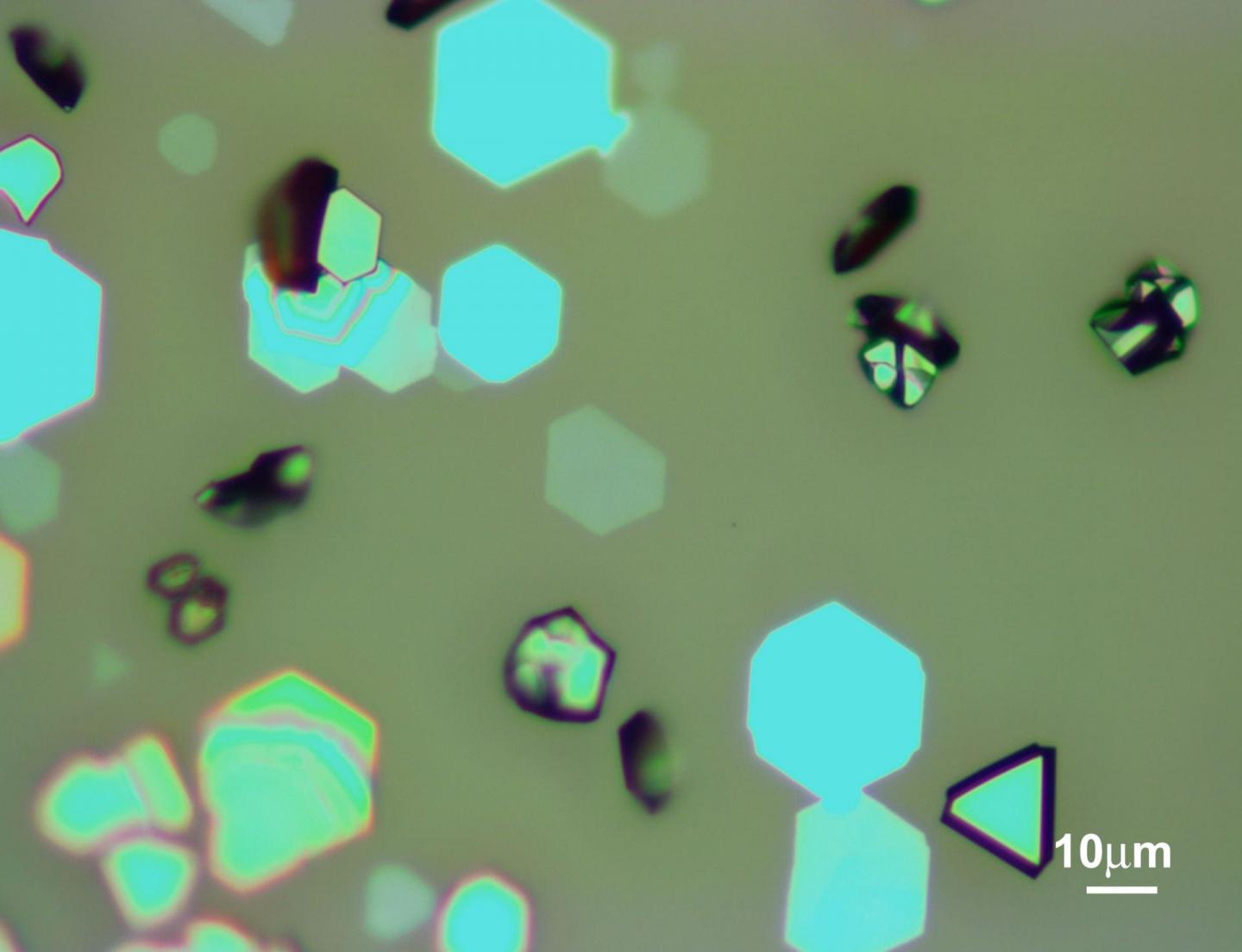Rare iron oxide could be combined with 2D materials for electronic, spintronic devices

Credit: Lou Group/Rice University
Rice University researchers have simplified the synthesis of a unique, nearly two-dimensional form of iron oxide with strong magnetic properties that is easy to stack atop other 2D materials.
The material, epsilon iron(III) oxide, shows promise as a building block for exotic nanoscale structures that could be useful for spintronic devices, electronic or storage applications that take advantage of not only the charge of electrons but also their spin states.
Researchers at Rice’s Brown School of Engineering and Wiess School of Natural Sciences reported in the American Chemical Society journal Nano Letters that they had produced oxide flakes through simple chemical vapor deposition. The flakes are easily transferable from their growth substrates and retain their magnetic properties over the long term at room temperature.
“Iron oxide is nothing new,” said Rice materials scientist and co-principal investigator Jun Lou. “But this epsilon phase is very rare. In epitaxial growth (in which the crystal aligns with the atomic structure of the surface), the bonding is strong and crystals are hard to transfer. But one of the features of this crystal structure is that it has relatively weak interaction with the substrate. You can pick it up and put it on different things.”
“An ultrathin magnetic material like this, which maintains its magnetic properties up to room temperature and can be integrated with other materials by stacking, is very exciting,” said Rice physicist Doug Natelson, a co-principal investigator with Lou and Scott Crooker of Los Alamos National Laboratory. “It will be a great testing ground for seeing how magnetic properties act across interfaces, an important aspect relevant to future information technologies.”
Lou said the material is technically not 2D, because of the prismlike orthorhombic atomic structure that gives the lattice its unusual properties. “But basically, it has all the features of a 2D magnet,” he said.
He said other 2D magnetic materials discovered to this point have two negative characteristics: Their Curie temperature is far below room temperature, meaning the materials need to be cooled to preserve their magnetic effects, or the materials are not structurally stable and decompose quickly in ambient conditions.
“Our material has neither of those problems,” Lou said. “It’s air-stable and the Curie temperature is slightly above room temperature. If we test the material we grew a year ago now, it still shows the same behavior.”
If the material were as thick as a refrigerator magnet, it too would stick. “The magnetic effect is very strong, around 300 milliTeslas,” Lou said. “But this material cannot exist in bulk. It will phase out of epsilon into some other kind of oxide.”
The researchers grew the smooth flakes, as thin as 5.1 nanometers, on silicon dioxide and mica substrates. They successfully tested its ability to bond via the weak van der Waals force with graphene. The flakes’ magnetic properties, measured at Los Alamos, were found to be stable at room temperature with a magnetic field between 200 and 400 milliTeslas.
The research is the result of an interdisciplinary Rice IDEA proposal by Lou, Natelson and Rice chemist Gustavo Scuseria to investigate the magnetic properties of 2D materials. They plan to combine the oxide with more 2D materials to see how its magnetic field affects the properties of heterostructures. “This interfacial coupling process is going to be very interesting for us,” Lou said.
Rice alumnus Jiangtan Yuan, now a postdoctoral researcher at Northwestern University, and Andrew Balk of the National High Magnetic Field Laboratory at Los Alamos, New Mexico, are co-lead authors of the study. Co-authors are assistant research professor Hua Guo, graduate students Qiyi Fang and Xuanhan Zhao, undergraduate Sahil Patel and research specialist Tanguy Terlier of the Shared Equipment Authority at Rice. Crooker is a technical staff member of the National High Magnetic Field Laboratory. Natelson is a professor of physics and astronomy, of electrical and computer engineering and of materials science and nanoengineering. Lou is a professor of materials science and nanoengineering and of chemistry.
###
The National Science Foundation, the Welch Foundation, the Department of Energy Basic Energy Sciences program and Rice IDEA supported the research.
Read the abstract at https:/
This news release can be found online at https:/
Follow Rice News and Media Relations via Twitter @RiceUNews.
Related materials:
Lou Group: https:/
Natelson Research Group: http://natelson.
National High Magnetic Field Laboratory: https:/
Department of Materials Science and NanoEngineering: https:/
Brown School of Engineering: https:/
Located on a 300-acre forested campus in Houston, Rice University is consistently ranked among the nation’s top 20 universities by U.S. News & World Report. Rice has highly respected schools of Architecture, Business, Continuing Studies, Engineering, Humanities, Music, Natural Sciences and Social Sciences and is home to the Baker Institute for Public Policy. With 3,962 undergraduates and 3,027 graduate students, Rice’s undergraduate student-to-faculty ratio is just under 6-to-1. Its residential college system builds close-knit communities and lifelong friendships, just one reason why Rice is ranked No. 1 for lots of race/class interaction and No. 2 for quality of life by the Princeton Review. Rice is also rated as a best value among private universities by Kiplinger’s Personal Finance.
Media Contact
David Ruth
[email protected]
Related Journal Article
http://dx.




